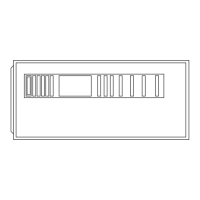3. Working from furnace to outside, cut pipe to required
length(s).
4. Deburr inside and outside of pipe.
5. Chamfer outside edge of pipe for better distribution of primer
and cement.
6. Clean and dry all surfaces to be joined.
7. Check dry fit of pipe and mark insertion depth on pipe.
NOTE: It is recommended that all pipes be cut, prepared, and
preassembled before permanently cementing any joint.
8. After pipes have been cut and preassembled, apply generous
layer of cement primer to pipe fitting socket and end of pipe
to insertion mark. Quickly apply approved cement to end of
pipe and fitting socket (over primer). Apply cement in a light,
Fig. 34—Short Vent (5 to 8 Ft) System
A96230
HORIZONTAL TO ROOF HORIZONTAL TO SIDEWALL
VERTICAL TO SIDEWALLVERTICAL TO ROOF
VENT PIPE
COMBUSTION-AIR PIPE COMBUSTION-AIR PIPE
VENT PIPE
COMBUSTION-AIR PIPE
VENT PIPE
COMBUSTION-AIR PIPE
VENT PIPE
12″ MIN
12″ MIN
12″ MIN
12″ MIN
NOTE
: A 12 In. minimum offset pipe section is recommended with
short (5 to 8 ft) vent systems. This recommendation is to reduce
excessive condensate droplets from exiting the vent pipe.
Table 6—Approved Combustion-Air and Vent Pipe, Fitting and Cement Materials
ASTM SPECIFICATION
(MARKED ON MATERIAL)
MATERIAL PIPE FITTINGS SOLVENT CEMENT AND PRIMERS DESCRIPTION
D1527 ABS Pipe — — Schedule-40
D1785 PVC Pipe — — Schedule-40
D2235 For ABS — —
Solvent
Cement
For ABS
D2241 PVC Pipe — — SDR-21 & SDR-26
D2466 PVC — Fittings — Schedule-40
D2468 ABS — Fittings — Schedule-40
D2564 For PVC — —
Solvent
Cement
For PVC
D2661 ABS Pipe Fittings — DWV at Schedule-40 IPS sizes
D2665 PVC Pipe Fittings — DWV
F438 CPVC — Fittings — Schedule-40
F441 CPVC Pipe — — Schedule-40
F442 CPVC Pipe — — SDR
F493 For CPVC — —
Solvent
Cement
For CPVC
F628 ABS Pipe — — Cellular Core DWV at Schedule-40 IPS sizes
F656 For PVC — — Primer For PVC
F891 PVC Pipe — — Cellular Core Schedule-40 & DWV
28

